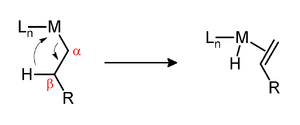
Transition metal alkyl complexes are coordination complexes that contain a bond between a transition metal and an alkyl ligand. Such complexes are not only pervasive but are of practical and theoretical interest.
Scope
Most metal alkyl complexes contain other, non-alkyl ligands. Great interest, mainly theoretical, has focused on the homoleptic complexes. Indeed, the first reported example of a complex containing a metal-sp carbon bond was the homoleptic complex diethylzinc. Other examples include hexamethyltungsten, tetramethyltitanium, and tetranorbornylcobalt.

Structure of diethylzinc. The Zn-C bonds measure 194.8(5) pm, while the C-Zn-C angle is slightly bent with 176.2(4)°.
Mixed ligand, or heteroleptic, complexes containing alkyls are numerous. In nature, vitamin B12 and its many derivatives contain reactive Co-alkyl bonds.

Hexamethyltungsten is an example of a "homoleptic" (all ligands being the same) metal alkyl complex.
| example | comment |
|---|---|
| Ti(CH3)4 | only observed as monoetherate, d |
| trigonal bipyramidal, d | |
| one bridging methyl ligand, d,d | |
| trigonal prismatic, d | |
| trigonal prismatic, d | |
| d | |
| d | |
| Mo(CH3)5 | d |
| W(CH3)6 | trigonal prismatic, d |
| 2- | d |
| 2- | d |
| d | |
| low-spin, d, square planar | |
| square planar, d | |
| d | |
| d | |
| d | |
| d | |
| d | |
| d | |
| Zn(CH3)2 | d |
| Cd(CH3)2 | d |
| Hg(CH3)2 | d |
Preparation
Metal alkyl complexes are prepared generally by two pathways, use of alkyl nucleophiles and use of alkyl electrophiles. Nucleophilic sources of alkyl ligands include Grignard reagents and organolithium compounds. Since many strong nucleophiles are also potent reductants, mildly nucleophilic alkylating agents are sometimes employed to avoid redox reactions. Organozinc compounds and organoaluminium compounds are such milder reagents.
Electrophilic alkylation commonly starts with low valence metal complexes. Typical electrophilic reagents are alkyl halides. Illustrative is the preparation of the methyl derivative of cyclopentadienyliron dicarbonyl anion:
- CpFe(CO)2Na + CH3I → CpFe(CO)2CH3 + NaI
Many metal alkyls are prepared by oxidative addition:
An example is the reaction of a Vaska's complex with methyl iodide.

Agostic interactions and beta-hydride elimination
Some metal alkyls feature agostic interactions between a C-H bond on the alkyl group and the metal. Such interactions are especially common for complexes of early transition metals in their highest oxidation states.
One determinant of the kinetic stability of metal-alkyl complexes is the presence of hydrogen at the position beta to the metal. If such hydrogens are present and if the metal center is coordinatively unsaturated, then the complex can undergo beta-hydride elimination to form a metal-alkene complex:

These conversions are assumed to proceed via the intermediacy of agostic interactions.
Catalysis
Many homogeneous catalysts operate via the intermediacy of metal alkyls. These reactions include hydrogenation, hydroformylation, alkene isomerization, and olefin polymerization. It is assumed that the corresponding heterogeneous reactions also involve metal-alkyl bonds.
References
- Oliveira, José; Elschenbroich, Christoph (2006). Organometallics (3., completely rev. and extended ed.). Weinheim: Wiley-VCH-Verl. ISBN 978-3-527-29390-2.
- ^ Hartwig, J. F. (2010). Organotransition Metal Chemistry, from Bonding to Catalysis. New York: University Science Books. ISBN 978-1-891389-53-5.
- ^ Kleinhenz, S.; Pfennig, V.; Seppelt, K. (1998). "Preparation and Structures of , , , and ". Chemistry – A European Journal. 4 (9): 1687–1691. doi:10.1002/(SICI)1521-3765(19980904)4:9<1687::AID-CHEM1687>3.0.CO;2-R.
- John Bacsa; Felix Hanke; Sarah Hindley; Rajesh Odedra; George R. Darling; Anthony C. Jones; Alexander Steiner (2011). "The Solid State Structures of Dimethylzinc and Diethylzinc". Angewandte Chemie International Edition. 50 (49): 11685–11687. doi:10.1002/anie.201105099. PMC 3326375. PMID 21919175.
- ^ Kleinhenz, Sven; Seppelt, Konrad (1999). "Preparation and Structures of Methyltitanium Compounds". Chemistry - A European Journal. 5 (12): 3573–3580. doi:10.1002/(SICI)1521-3765(19991203)5:12<3573::AID-CHEM3573>3.3.CO;2-F.
- ^ Morse, Paige M.; Girolami, Gregory S. (1989). "Are d0 ML6 complexes always octahedral? The x-ray structure of trigonal-prismatic [Li(tmed)]2[ZrMe6]". Journal of the American Chemical Society. 111 (11): 4114–4116. doi:10.1021/ja00193a061.
- Beatrice Roessler; Sven Kleinhenza; Konrad Seppelt (2000). "Pentamethylmolybdenum". Chemical Communications (12): 1039–1040. doi:10.1039/b000987n.
- Morris, Robert J.; Girolami, Gregory S. (1988). "Permethylmanganates. Synthesis and characterization of divalent [MnMe42-], trivalent [MnMe52-], and tetravalent [MnMe62-]". Journal of the American Chemical Society. 110 (18): 6245–6246. doi:10.1021/ja00226a049. PMID 22148809.
- Morris, Robert J.; Girolami, Gregory S. (1991). "High-valent organomanganese chemistry. 1. Synthesis and characterization of manganese(III) and -(IV) alkyls". Organometallics. 10 (3): 792–799. doi:10.1021/om00049a047.
- Al-Afyouni, Malik H.; Fillman, Kathlyn L.; Brennessel, William W.; Neidig, Michael L. (2014). "Isolation and Characterization of a Tetramethyliron(III) Ferrate: An Intermediate in the Reduction Pathway of Ferric Salts with MeMg Br". Journal of the American Chemical Society. 136 (44): 15457–15460. doi:10.1021/ja5080757. PMC 4227835. PMID 25333789.
- Carpenter, Stephanie H.; Brennessel, William W.; Neidig, Michael L. (2019). "Isolation and Characterization of a Homoleptic Tetramethylcobalt(III) Distorted Square-Planar Complex". Organometallics. 38 (19): 3486–3489. doi:10.1021/acs.organomet.9b00387. S2CID 203144530.
- ^ Hay-Motherwell, Robyn S.; Wilkinson, Geoffrey; Hussain, Bilquis; Hursthouse, Michael B. (1989). "Homoleptic methyl compounds of rhodium and iridium(III). X-Ray crystal structures of tetramethylethylenediamine lithium hexamethyl-rhodate(III) and -iridate(III)". Journal of the Chemical Society, Chemical Communications (19): 1436. doi:10.1039/C39890001436.
- Walther, Dirk; Stollenz, Michael; Görls, Helmar (2001). "Dinuclear [RNi(oxam)NiR] Complexes (Oxam = N1,N2-bis(2-pyridylmethyl)-N3,N4-bis(2,4,6-trimethylphenyl)oxalamidinate; R = Me, Ph, C⋮CH, C⋮CPH): Reactions of the Methyl Complex and Formation of [Li(THF)]2Li2Ni2Me8 and [Li(THF)]4Ni2Me8". Organometallics. 20 (20): 4221–4229. doi:10.1021/om000960u.
- Wyrwa, R.; Görls, H. (1999). "Ungewöhnliche Molekülstrukturen für Platin(II)-at-Komplexe". Zeitschrift für Anorganische und Allgemeine Chemie. 625 (11): 1904–1907. doi:10.1002/(SICI)1521-3749(199911)625:11<1904::AID-ZAAC1904>3.0.CO;2-2.
- ^ Zhu, Dunming; Lindeman, Sergey V.; Kochi, Jay K. (1999). "X-ray Crystal Structures and the Facile Oxidative (Au−C) Cleavage of the Dimethylaurate(I) and Tetramethylaurate(III) Homologues". Organometallics. 18 (11): 2241–2248. doi:10.1021/om990043s.
- King, B. (1970). "Applications of Metal Carbonyl Anions in the Synthesis of Unusual Organometallic Compounds". Acc. Chem. Res. 3 (12): 417–427. doi:10.1021/ar50036a004.
- Z. Dawoodi; M. L. H. Green; V. S. B. Mtetwa; K. Prout; A. J. Schultz; J. M. Williams; T. F. Koetzle (1986). "Evidence for Carbon–Hydrogen–Titanium Interactions: Synthesis and Crystal Structures of the Agostic alkyls [TiCl3(Me2PCH2CH2PMe2)R] (R = Et or Me)". J. Chem. Soc., Dalton Trans. (8): 1629. doi:10.1039/dt9860001629.
- Scherer, W.; McGrady, G. S. (2004). "Agostic Interactions in d Metal Alkyl Complexes". Angew. Chem. Int. Ed. 43 (14): 1782–1806. doi:10.1002/anie.200200548. PMID 15054779.
- Forbes, Jeffrey G.; Gellman, Andrew J. (1993-07-01). "The .beta.-hydride elimination mechanism in adsorbed alkyl groups". Journal of the American Chemical Society. 115 (14): 6277–6283. doi:10.1021/ja00067a048. ISSN 0002-7863.
| Coordination complexes | |
|---|---|
| H donors: | |
| B donors: | |
| C donors: | |
| Si donors: | |
| N donors: | |
| P donors: | |
| O donors: | |
| S donors: | |
| Halide donors: | |
